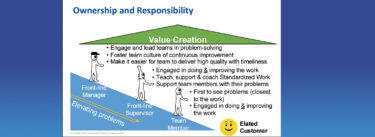This 2007 Jim Womack article shares a powerful definition of respect for people. In his book Gemba Walks, Jim shared the following brief excerpt; his full essay follows after that:
Let’s suppose that you and I want to tap the creative, process-improving energies of the people touching every process in our organizations. That is, we want to truly engage every member of our organization in continuous improvement. How can we do that? This is a deeply human matter requiring us to rethink what it really means to show respect for people.
For years I’ve visited companies where “respect for people” is a core element of the corporate philosophy. So I’ve asked managers in many companies a simple question. “How do you show respect?” I have usually heard that employees should be treated fairly, given clear goals, trusted to achieve them in the best way, and held to account for results. For example, “We hire smart people, we give them great latitude in how they do their work because we trust them, and we hold them to objective measures of performance. That’s respect for people.”
Over time I’ve come to realize that this problem-solving process is actually the highest form of respect. When in recent years Toyota made respect for people one of the pillars of the Toyota Way I decided I should ask the best Toyota managers how they show respect for people. The answer I have heard is a good bit different from what I’ve heard at many other companies and goes as follows:
Managers begin by asking employees what the problem is with the way their work is currently being done. Next they challenge the employees’ answer and enter into a dialogue about what the real problem is. (It’s rarely the problem showing on the surface.)
Then they ask what is causing this problem and enter into another dialogue about its root causes. (True dialogue requires the employees to gather evidence on the gemba – the place where value is being created — for joint evaluation.)
Then they ask what should be done about the problem and ask employees why they have proposed one solution instead of another. (This generally requires considering a range of solutions and collecting more evidence.)
Then they ask how they – manager and employees – will know when the problem has been solved, and engage one more time in dialogue on the best indicator.
Finally, after agreement is reached on the most appropriate measure of success, the employees set out to implement the solution.
For many of us that doesn’t sound much like respect for people. The manager after all doesn’t just say “I trust you to solve the problem because I respect you. Do it your way and get on with it.” And the manager isn’t a morale booster, always saying, “Great job!” Instead the manager challenges the employees every step of the way, asking for more thought, more facts, and more discussion, when the employees just want to implement their favored solution.
Over time I’ve come to realize that this problem-solving process is actually the highest form of respect. The manager is saying to the employees that the manager can’t solve the problem alone, because the manager isn’t close enough to the problem to know the facts. He or she truly respects the employees’ knowledge and their dedication to finding the best answer. But the employees can’t solve the problem alone either because they are often too close to the problem to see its context and they may refrain from asking tough questions about their own work. Only by showing mutual respect – each for the other and for each other’s role – is it possible to solve problems, make work more satisfying, and move organizational performance to an ever higher level.
Recently I walked through two distribution centers in the same city providing the same type of service for their customers. As I walked I found a wonderfully clear example of the difference that mutual respect for people makes.
In the first facility management was focused on controlling the workforce through individual metrics. Employees were told to get a given amount of work done but given considerable latitude on just how to do it. They were judged at the end of the day, week, month, and quarter on whether they achieved the desired results, using data collected by a computerized tracking system. Front-line managers were busily engaged in working around current problems but none was systematically engaged in actually solving these problems at the root cause in collaboration with the employees. This was a task for higher-level managers and staff experts as time permitted, usually without the involvement of the production associates.
In the second facility, the management had worked with employees to create standard work for every task and had The challenge for those of us in the Lean Community is to embrace and explain the true nature of mutual respect for people – managers and associates – so all organizations can move toward a new and better way of solving their problems.introduced visual control with status boards so everyone could see how everyone else was proceeding with their work. Because the condition of the entire process was instantly visible to everyone, employees could help each other with any problems which emerged. And because the work process was very stable due to strict adherence to standardized work, line managers could devote most of their energy to problem solving by engaging production associates in dialogues to get to root causes and implement sustainable solutions. Indeed, every associate spent four hours every week on improvement activities.
What is the result? Both facilities are in the same city, have employees with the same educational level, and pay roughly the same wage. Yet annual turnover of associates in the first facility is 70 percent (which seems to be typical in distribution centers) and there is significant management turnover as well. Meanwhile, in the second facility, associate turnover is 1 percent and practically no managers leave. When I asked managers and associates in the second center why this should be, the answer was simple: “The work here is always challenging because we are always solving problems using a method we all understand. And we all respect each other’s contribution.”
The differences continue: In my rough estimate labor productivity in the second facility is about twice that of the first even with less automation. This is partly because the first facility is constantly hiring and training new employees while the second distribution center spends practically no time on this task. In addition, all employees in the second facility are experienced and working at the top of their learning curve. Large amounts of confusion about what to do next and larger amounts of rework are eliminated.
Finally, in the second facility, quality as experienced by customers is higher as well even though there is less internal rework. And the total amount of inventory on hand to provide the next-day service that both facilities promise their customers is also much lower in the second distribution center.
I trust you can guess which facility is a Toyota parts distribution center and which facility belongs to a distribution firm stuck (like most) in the age of mass production with command-and-control management methods but little discussion of how employees can best do their jobs.
I also trust that all of us want to show respect for people. The challenge for those of us in the Lean Community is to embrace and explain the true nature of mutual respect for people – managers and associates – so all organizations can move toward a new and better way of solving their problems.






